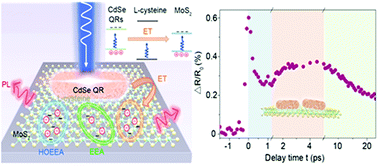Photoluminescence enhancement of MoS2/CdSe quantum rod heterostructures induced by energy transfer and exciton–exciton annihilation suppression†
Abstract
Energy transfer in heterostructures is an essential interface interaction for extraordinary energy conversion properties, which promote promising applications in light-emitting and photovoltaic devices. However, when atomic-layered transition metal dichalcogenides (TMDCs) act as the energy acceptor because of strong Coulomb interactions, the transferred energy can be consumed by nonradiative exciton annihilations, which hampers the development of light-emitting devices. Hence, revealing the mechanism of energy transfer and the related relaxation processes from the aspect of the acceptor in the heterostructure is key to reducing nonradiative loss and optimizing luminescence. Here, we study the exciton dynamics from the standpoint of the acceptor in MoS2/CdSe quantum rod (QR) heterostructures and realize efficiently enhanced photoluminescence (PL). Through femtosecond pump–probe measurements, it is directly observed that energy transfer from CdSe QRs largely raises the exciton population of the acceptor, MoS2, providing a larger emission “source”. In addition, the dielectric environment introduced by CdSe QRs efficiently enhances the PL by suppressing exciton–exciton annihilation (EEA). This study provides new insights for on-chip applications such as light-emitting diodes and optical conversion devices based on low dimensional semiconductor heterostructures.

- This article is part of the themed collections: Top articles from NCNST and Research selection from the NCNST


 Please wait while we load your content...
Please wait while we load your content...